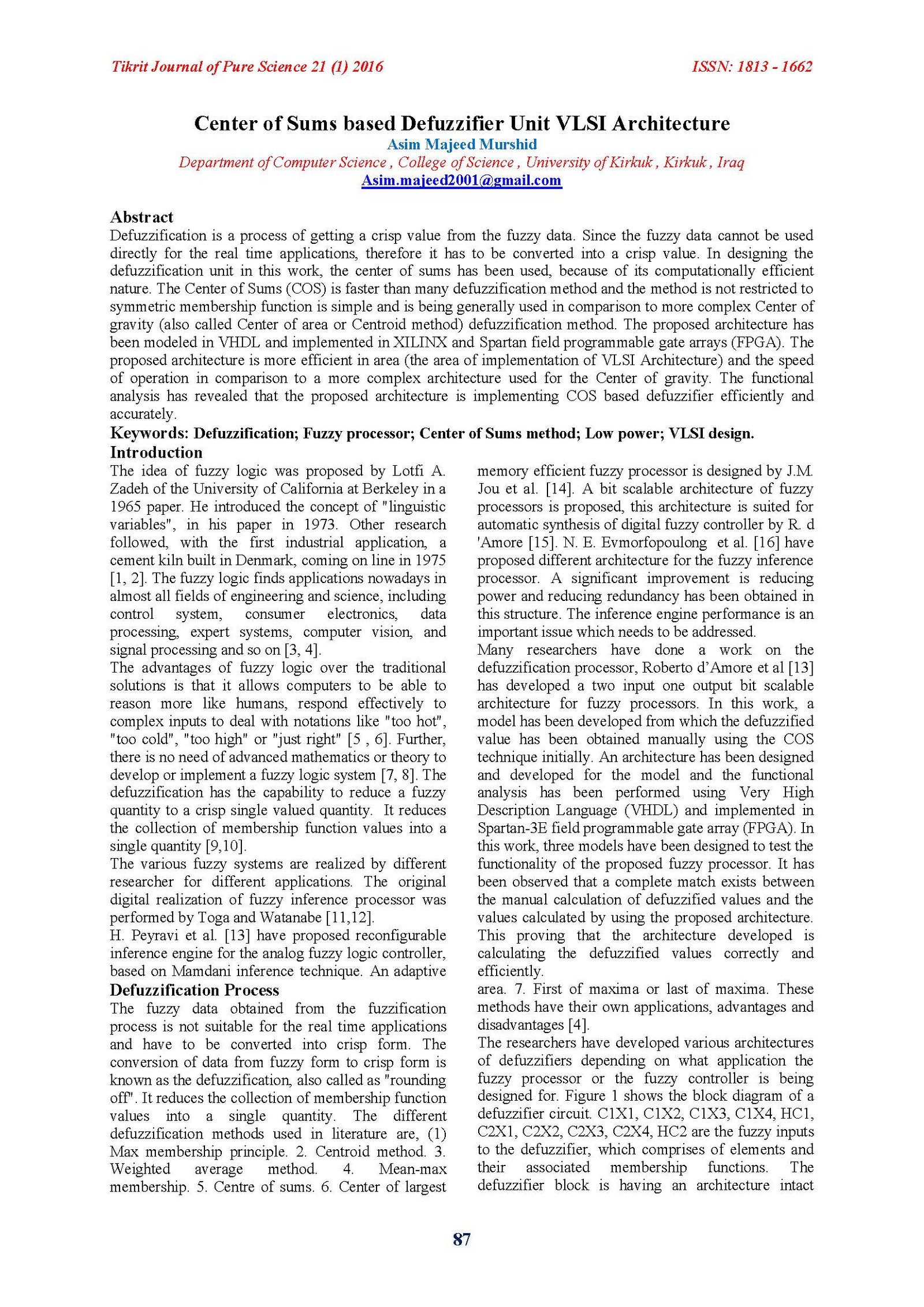Center of Sums based Defuzzifier Unit VLSI Architecture
Main Article Content
Abstract
Defuzzification is a process of getting a crisp value from the fuzzy data. Since the fuzzy data cannot be used directly for the real time applications, therefore it has to be converted into a crisp value. In designing the defuzzification unit in this work, the center of sums has been used, because of its computationally efficient nature. The Center of Sums (COS) is faster than many defuzzification method and the method is not restricted to symmetric membership function is simple and is being generally used in comparison to more complex Center of gravity (also called Center of area or Centroid method) defuzzification method. The proposed architecture has been modeled in VHDL and implemented in XILINX and Spartan field programmable gate arrays (FPGA). The proposed architecture is more efficient in area (the area of implementation of VLSI Architecture) and the speed of operation in comparison to a more complex architecture used for the Center of gravity. The functional analysis has revealed that the proposed architecture is implementing COS based defuzzifier efficiently and accurately.
Article Details

This work is licensed under a Creative Commons Attribution 4.0 International License.
Tikrit Journal of Pure Science is licensed under the Creative Commons Attribution 4.0 International License, which allows users to copy, create extracts, abstracts, and new works from the article, alter and revise the article, and make commercial use of the article (including reuse and/or resale of the article by commercial entities), provided the user gives appropriate credit (with a link to the formal publication through the relevant DOI), provides a link to the license, indicates if changes were made, and the licensor is not represented as endorsing the use made of the work. The authors hold the copyright for their published work on the Tikrit J. Pure Sci. website, while Tikrit J. Pure Sci. is responsible for appreciate citation of their work, which is released under CC-BY-4.0, enabling the unrestricted use, distribution, and reproduction of an article in any medium, provided that the original work is properly cited.
References
[1] L. A. Zadeh, “Fuzzy logic”, IEEE Computer, vol.1 no. 4, pp. 83–93, 1988.
[2] T. J. Ross, “fuzzy logic with engineering applications," by John Wiley Sons inc., 2005.
[3] E. H. Mamdani, “Applications of fuzzy algorithm for simple dynamic plant”, Proc. Inst. Elect. Eng., Vol. 121, pp. 1585-1588, 1974.
[4] C. C. Lee, “Fuzzy logic in control systems: fuzzy logic controller-part I”, IEEE Trans. Syst., Man. Cybern., Vol. 20, no. 2, pp. 404-418, 1990.
[5] A. M. Murshid, S. A. Loan, S. A. Abbasi, and A. M. Alamoud, “VLSI Architecture of Fuzzy Logic Hardware Implementation: a Review," Int. Journal of Fuzzy Systems, Vol. 13, No. 2, pp. 74-88, June 2011.
[6] A. M. Murshid, S. A. Loan, S. A. Abbasi, and A. M. Alamoud, “A ovel VLSI architecture for a fuzzy inference processor using Triangular-shaped membership function," Int. Journal of Fuzzy Systems, Vol. 14, No. 3, pp. 345-360, Sep. 2012
[7] S. A. Loan, A. M. Murshid, S. A. Abbasi, and A. M. Alamoud, “A novel VLSI architecture for a fuzzy inference processor using Gaussian-shaped membership function," Journal of Intelligent and fuzzy systems, vol.23, pp. 1-16, 2012.
[8] Sajad A. Loan, Asim M. Murshid and Faisal Bashir, “A Novel VLSI Architecture of a Defuzzifier Unit for a Fuzzy Inference Processor’, in proceedings of IEEE ICEASE 2013.
[9] Sajad A. Loan, Asim M. Murshid, Ahmed C. Shakir, Abdul Rahman Alamoud and Shuja A. Abbasi, “A Novel VLSI Architecture of a Weighted Average Method based Defuzzifier Unit’, in proceedings of International MultiConference of
Engineers and Computer Scientiists, Hong Kong, 12-14 March, 2014.
[10] A. M. Murshid, S. A. Loan, S. A. Abbasi, and A. M. Alamoud, “A Novel Multi Membership Function Based VLSI Architecture of a fuzzy inference processor," Int. Journal of Fuzzy Systems, Vol. 16, No. 4, pp. 468-482, Dec. 2014.
[11] H. Watanabe, W. D. Dettloff, and K. E. Yount, “A VLSI fuzzy logic Controller with reconfigurable, cascade architecture”, IEEE Journal of Solid-State Circuits, Vol. 25, pp. 376-381, 1990.
[12] M. Togai and H. Watanabe, “Expert system on a chip: an engine for real-Time approximate reasoning”, IEEE Expert Mag., Vol. 1, pp. 55- 62, 1986.
[13] H. Peyravi, A. Khoei, and K. Hadidi, “Design of an analog CMOS fuzzy logic controller chip”, Fuzzy Sets and Systems 132, PP. 254- 260, 2002.
[14] J. M. Jou and P. Y. Chen”, “An adaptive fuzzy logic controller: its VLSI architecture and applications”, IEEE Trans. Very Large Scale Integration (VLSI) Systems, Vol. 8, pp. 52-60, 2000.
[15] R. d’Amore, O. Saotome, and K. H. Kientiz, “A Two – Input, One – Output Bit – Scalable Architecture for Fuzzy Processors,” IEEE Computer Society press, vol. 18, pp. 56-64, July 2001.
[16] N. E. Evmorfopoulos, and J. N. Avaritsiots, “An adaptive digital fuzzy architecture for application-specific integrated circuits”, Active and Passive Elec. Comp., Vol. 25, pp. 289-306, 2002.
[17] S. N. Sivanandam, S. Sumathi, and S. N. Deepa, "Introduction to Fuzzy Logic using MATLAB", by Springer, 2007.
